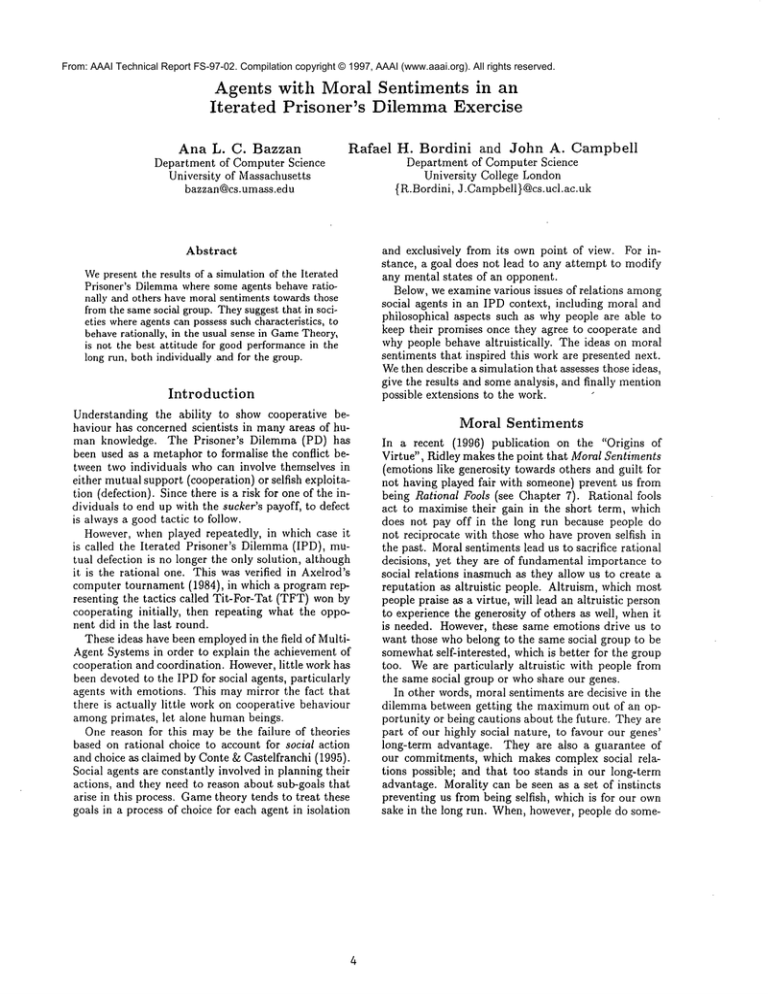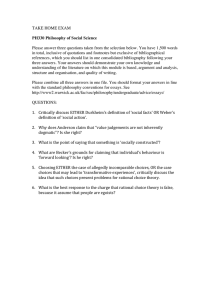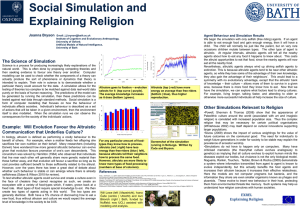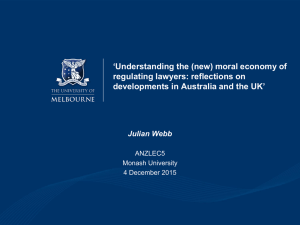
From: AAAI Technical Report FS-97-02. Compilation copyright © 1997, AAAI (www.aaai.org). All rights reserved.
Agents with Moral Sentiments in an
Iterated Prisoner’s Dilemma Exercise
Ana L. C. Bazzan
Department of Computer Science
University of Massachusetts
bazzan@cs.umass.edu
Rafael
Abstract
Wepresent the results of a simulation of the Iterated
Prisoner’s Dilemmawhere some agents behave rationally and others have moral sentiments towards those
from the same social group. They suggest that in societies where agents can possess such characteristics, to
behave rationally, in the usual sense in GameTheory~
is not the best attitude for good performance in the
long run, both individually and for the group.
Introduction
Understanding the ability to show cooperative behaviour has concerned scientists
in many areas of human knowledge. The Prisoner’s
Dilemma (PD) has
been used as a metaphor to formalise the conflict between two individuals who can involve themselves in
either mutual support (cooperation) or selfish exploitation (defection). Since there is a risk for one of the individuals to end up with the sucker’s payoff, to defect
is ahvays a good tactic to follow.
However, when played repeatedly, in which case it
is called the Iterated Prisoner’s Dilemma (IPD), mutual defection is no longer the only solution, although
it is the rational one. This was verified in Axelrod’s
computer tournament (1984), in which a program representing the tactics called Tit-For-Tat (TFT) won
cooperating initially,
then repeating what the opponent did in the last round.
These ideas have been employed in the field of MultiAgent Systems in order to explain the achievement of
cooperation and coordination. However, little work has
been devoted to the IPD for social agents, particularly
agents with emotions. This may mirror the fact that
there is actually little work on cooperative behaviour
among primates, let alone human beings.
One reason for this may be the failure of theories
based on rational choice to account for social action
and choice as claimed by Conte &: Castelfranchi (1995).
Social agents are constantly involved in planning their
actions, and they need to reason about sub-goals that
arise in this process. Gametheory tends to treat these
goals in a process of choice for each agent in isolation
H. Bordini
and John
A. Campbell
Department of Computer Science
University College London
{R.Bordini, J.Campbell}@cs.ucl.ac.uk
and exclusively from its own point of view. For instance, a goal does not lead to any attempt to modify
any mental states of an opponent.
Below, we examine various issues of relations among
social agents in an IPD context, including moral and
philosophical aspects such as why people are able to
keep their promises once they agree to cooperate and
why people behave altruistically.
The ideas on moral
sentiments that inspired this work are presented next.
Wethen describe a simulation that assesses those ideas,
give the results and some analysis, and finally mention
possible extensions to the work.
Moral
Sentiments
In a recent (1996) publication
on the "Origins
Virtue", Ridley makes the point that Moral Sentiments
(emotions like generosity towards others and guilt for
not having played fair with someone) prevent us from
being Rational Fools (see Chapter 7). Rational fools
act to maximise their gain in the short term, which
does not pay off in the long run because people do
not reciprocate with those who have proven selfish in
the past. Moral sentiments lead us to sacrifice rational
decisions, yet they are of fundamental importance to
social relations inasmuch as they allow us to create a
reputation as altruistic
people. Altruism, which most
people praise as a virtue, will lead an altruistic person
to experience the generosity of others as well, when it
is needed. However, these same emotions drive us to
want those who belong to the same social group to be
somewhat self-interested,
which is better for the group
too. We are particularly
altruistic
with people from
the same social group or who share our genes.
In other words, moral sentiments are decisive in the
dilemma between getting the maximumout of an opportunity or being cautions about the future. They are
part of our highly social nature, to favour our genes’
long-term advantage. They are also a guarantee of
our commitments, which makes complex social relations possible; and that too stands in our long-term
advantage. Morality can be seen as a set of instincts
preventing us from being selfish, which is for our own
sake in the long run. When, however, people do some-
it does this to help the opponent to earn more points
(rememberthat the agent has a special feeling for this
opponent because they. are both from the same social
group). A poor altruist cooperates if the opponent is
in either a mediumor a poor state, because the poor
altruist does not try to recover by taking advantage
of a peer that is not in a wealthy state. However,an
altruistic agent will defect whenin a poor state if the
opponent is in a wealthy one and belongs to the same
group. This is a social mechanismto allow agents to
recover from a bad state, which is possible through the
altruism of those from the samegroup. Briefly, an altruist cooperates with those of the same group unless
it is in a poor state and the opponentis wealthy.
Next, we analyse the results of a particular configuration of the simulation whose main features we have
just described.
thing that is not rational and does not pay off even
ill the long run (true altruism), they are falling prey
to sentiments originally designed to obtain other people’s trust, whichis convenientfor real life’s "prisoner’s
dilemmas"1.
These are the general ideas that have inspired the
conception of the simulation we describe below. Similar ideas were also developed by Simon(1990).
Agents with Moral Sentiments
and IPD
Weare interested in analysing the performance of
groups of agents playing the IPD in the presence of
agents with moral sentiments (altruistic agents) or rational fools (egoistic agents) in that group; we also
analyse the individual performance of each type of
agent in the possible contexts (in a group where all
agents are exclusively of one of the twotypes just introduced or in a mixed group). The fact that two agents
belong to the same group in this simulation implies
that they have somesort of emotional liaison (that is,
they maybelong to the same family or social group).
Agents should be interested in the good performance
of their group as a whole, as well as their own, since
the social groupprovides also a base for support in case
the agent itself is not performingwell. However,that is
not. true for the egoist agents, whichalwaysseek to obtain maximumpoints, no matter with whomthey are
playing. Weaim to demonstrate Ridley’s point that
tile presence of agents with moral sentiments favours
the well-being of the wholesocial group.
In this experiment, the pairs of agents playing the
IPD are chosen randomly from all groups. Agents pay
one point to play (representing the effort one puts into
interacting socially). If an agent runs too lowin points
(because, e.g., it has played with several egoists) it
said to be bankrupt, in which case it is not allowed to
play, but it recovers by earning one point so that it can
afford to pay for the play in the next step of simulation.
Ttle points agents earn by playing are the standard
amounts for the PD payoff matrix: R = 3, S = 0,
T = 5, and P = 1. In order to determine the wealth
state of an altruistic agent (which influences howit
will play), we compute the average numberof points
through the completed simulation steps. According to
certain thresholds on this average, an agent’s state can
be wealthy, medium,or poor.
Egoistic agents defect in all interactions (ALLD).Altruistic agents play Tit-For-Tat (TFT) when playing
with agents from other groups, so they play a fair game
here. Wheninteracting with agents from the same social group, an altruistic agent plays with MoralSentiments (MS), whichis explained next. If the altruist
in a wealthy state and the opponent (from the same
group) is in a poor one, the agent cooperates despite
the fact that it knowsthat the opponentwill defect;
"To Be Good Pays Off"
Weconsider the particular results for the simulation of
a society of agents composedof 3 groups, each one with
4 agents. Oneof the groups has no egoist agents (G1),
another is a mixedgroup (G2) with 2 egoists and 2 altruists, and the third group (G3) is composedsolely
egoists. Figure 1 showsthe performance of each group
for the average of 50 repetitions of the simulation.
1~
GI(410)-G2(412}--~
G3(4/4)....
80
2°1
0
.............
20
40
60
6£1
i ..................
100
120
Figure 1: Simulation with 3 Groups and 12 Agents, of
which 6 are Egoists.
The results showclearly that, in the long run, homogeneousgroups of altruistic agents accumulate more
points than any other type of group. The altruists are
not rational fools; they compromisetheir present possibilities of gain to makesure they will do well in the
future. The whole group performs well because individual failures are compensatedby the generosity of
those doing well, avoiding bankruptcy. Therefore, to
be altruistic does pay off in the long run! Wehave
also verified that homogeneousgroups of egoists perform very well only in the short term. Their selfishness
in the game compromises their reputation: once the
~Recallthat, as Ridleyputs it, this is onlya dilemma
if
one does not knowif one can trust one’s accomplice.
5
agents in a society have found out about their character, they suffer retaliation (characteristic of the TFT).
At this point, egoists only earn enoughpoints to survive, that is, pay to play in the next step (which is
whythe graph for G3 in Figure 1 is horizontal, once
it stabilises). Briefly, their performancehas a logarithmic curve. Mixed groups have an intermediate performance, but they clearly do not exhibit the catastrophic effect of a group where there are no altruists.
The presence of somealtruists there assures the relative developmentof the group.
Wehave also inspected the performance of individual agents, e.g. as in Figure 2 (again 50 repetitions).
There, we use four different types of line, for the
different types of agents and group contexts2: altruistic agents in a homogeneous
group (AH), altruists
a mixed group (AM), egoists in a mixed group (EM),
and egoists in a homogeneousgroup (EH).
Figure 2: Individual Performances for the Simulation
with 3 Groups and 12 Agents, of which 6 are Egoists.
This gives us further insights. Unexpectedly,egoists
from the mixed group (EM) perform better than the
altruists (AM)in that group. This is because these
egoists can count on the generosity of the altruists in
their group, whocooperate with them despite the fact
that they are selfish, for the sake of kinship welfare.
However,we notice that the presence of the egoists is
harmful for all membersof the group in the long run,
since they wouldall be performingbetter if the egoists
wouldstop being rational fools (see the performanceof
the agents in group G1).
From other configurations of the simulation (e.g.,
different numbersof groups, agents and percentage of
each type of agent in the groups), whosegraphs we do
not have the space to showhere, we have also reached
further conclusions:
2Altruists and egoists havedifferent performanceswhen
t.hey are in homogeneous
or mixedgroups, whichis whythe
distinction is important.
* the more egoist agents (keeping the same configuration), the worse the general performance of the
society (as a whole); that is, the fewer total points
(from all agents in all groups) are accumulated
the same period;
. the more egoists in a group, the faster the group
collects points initially, but the worseits eventual
performance will be after sometime; the fewer egoists in a group, the better the group’s performance;
¯ the smaller the percentage of egoists in a mixed
group, the better the performanceof each individual
egoist agent (some interesting quantitative details
remain to be investigated).
Several other ideas can be exploited by changing the
various parameters to the simulation. Weintend to
report on these in further papers.
Conclusions
Our results suggest strongly that rational fools maximise their earnings in the short term but compromise
their performance in the long run. The results also
clearly show that the more altruists in a group, the
better they, and the group as a whole, perform. Accordingly, in a society where agents have emotions, to
behave rationally (in the classical sense in GameTheory) maynot be the best attitude in the" long run.
Other configurations of agents and groups of agents
were considered and will be presented in a future paper.
Weshall also present there the results for a slightly
different version of this simulation, where agents are
not given points to recover but are allowed to receive
negative points. Besides, in that version, not all agents
play at every simulation step; the moreagents are allowed to play in each step, the wealthier the society,
since it denotes that more opportunities for business
(in the form of PDinteraction) exist at each instant
in the society. Finally, we also plan to introduce some
sort of learning process from which agents can discover
the characters of others and eventually refuse themas
partners in future social interactions, as Ridley argues
to be the case amonghumans.
Acknowledgements
Rafael H. Bordini gratefully acknowledgesthe Brazilian agency CAPES
for the grant for his PhDat UCL.
References
Axelrod, R. 1984. The Evolution of Cooperation. New
York: Basic Books.
Conte, R., and Castelfranchi, C. 1995. Cognitive and
Social Action. London: UCLPress. 215p.
Ridley, M. 1996. The Origins of Virtue. International
Series in ComputerScience. London:Viking Press.
Simon, H. A. 1990. A mechanism for social selection and successful altruism. Science 250(4988):16651668.






